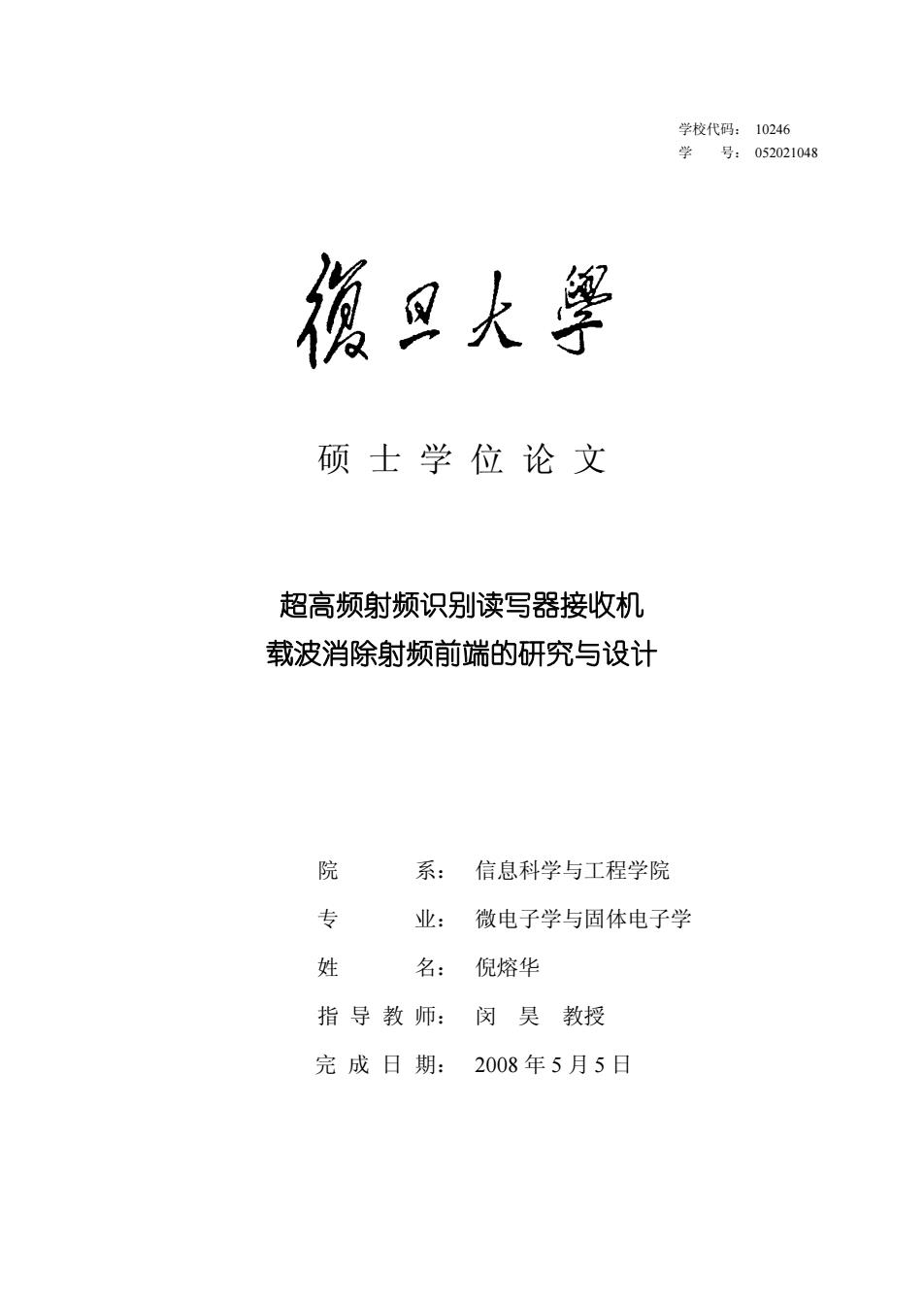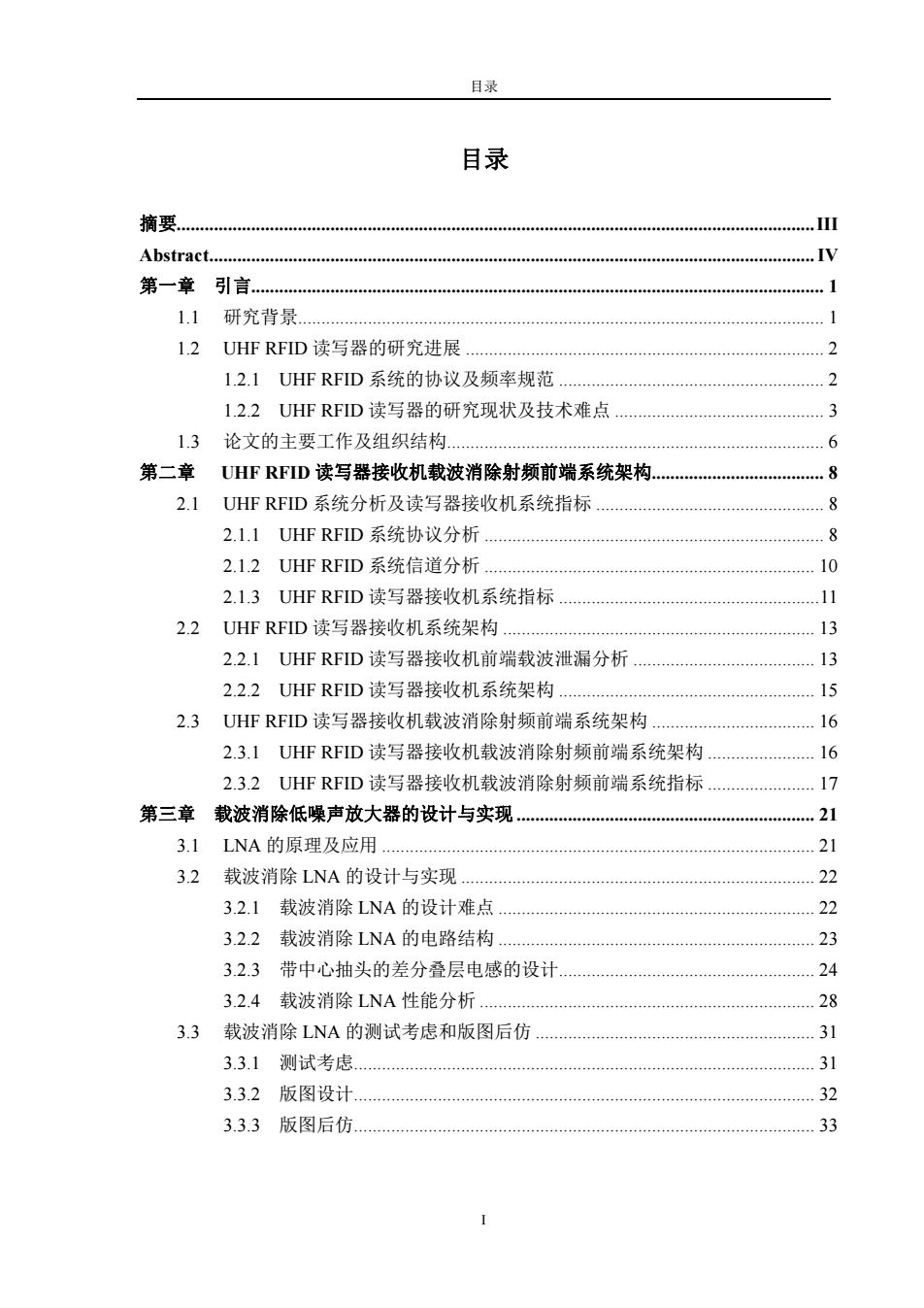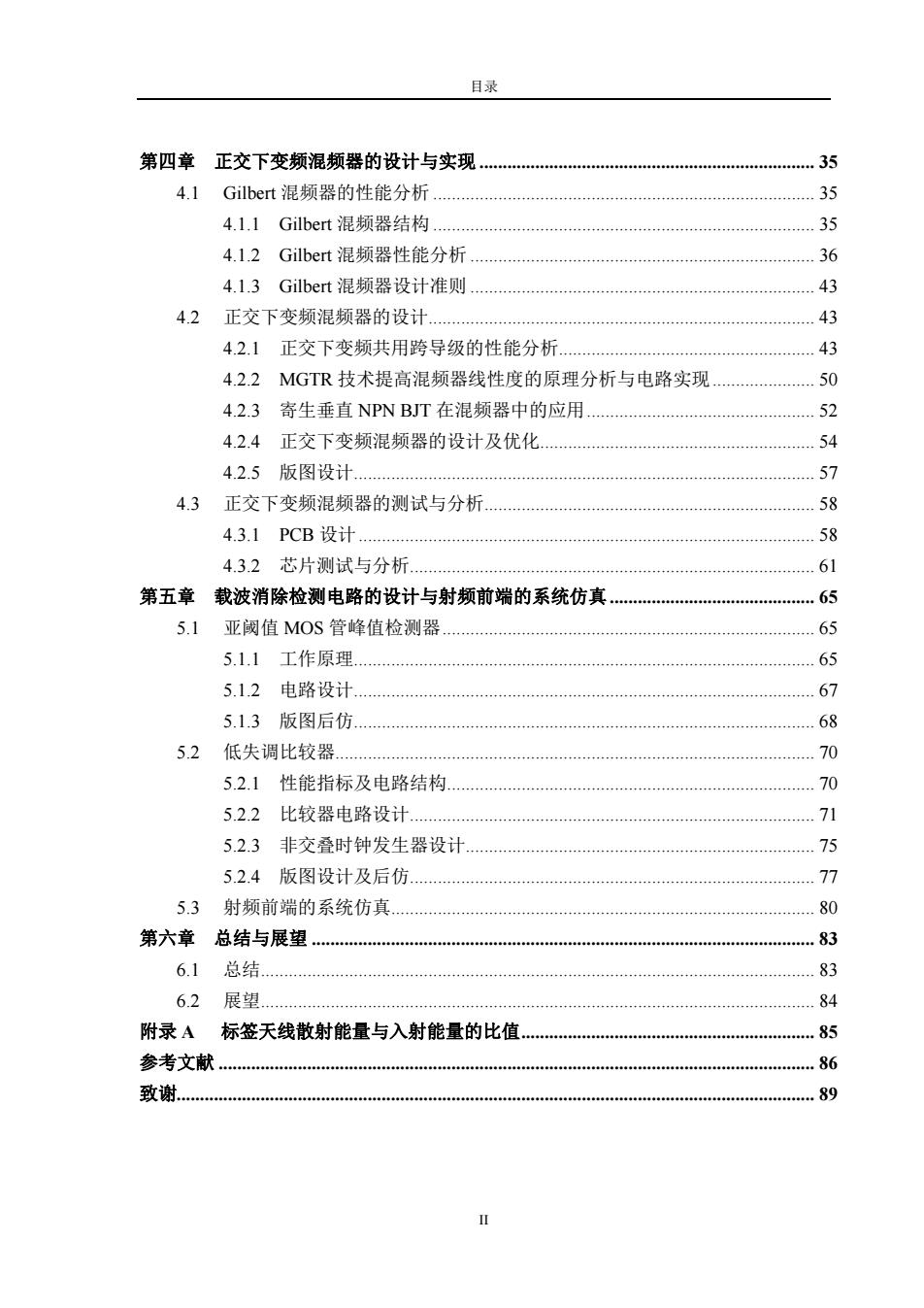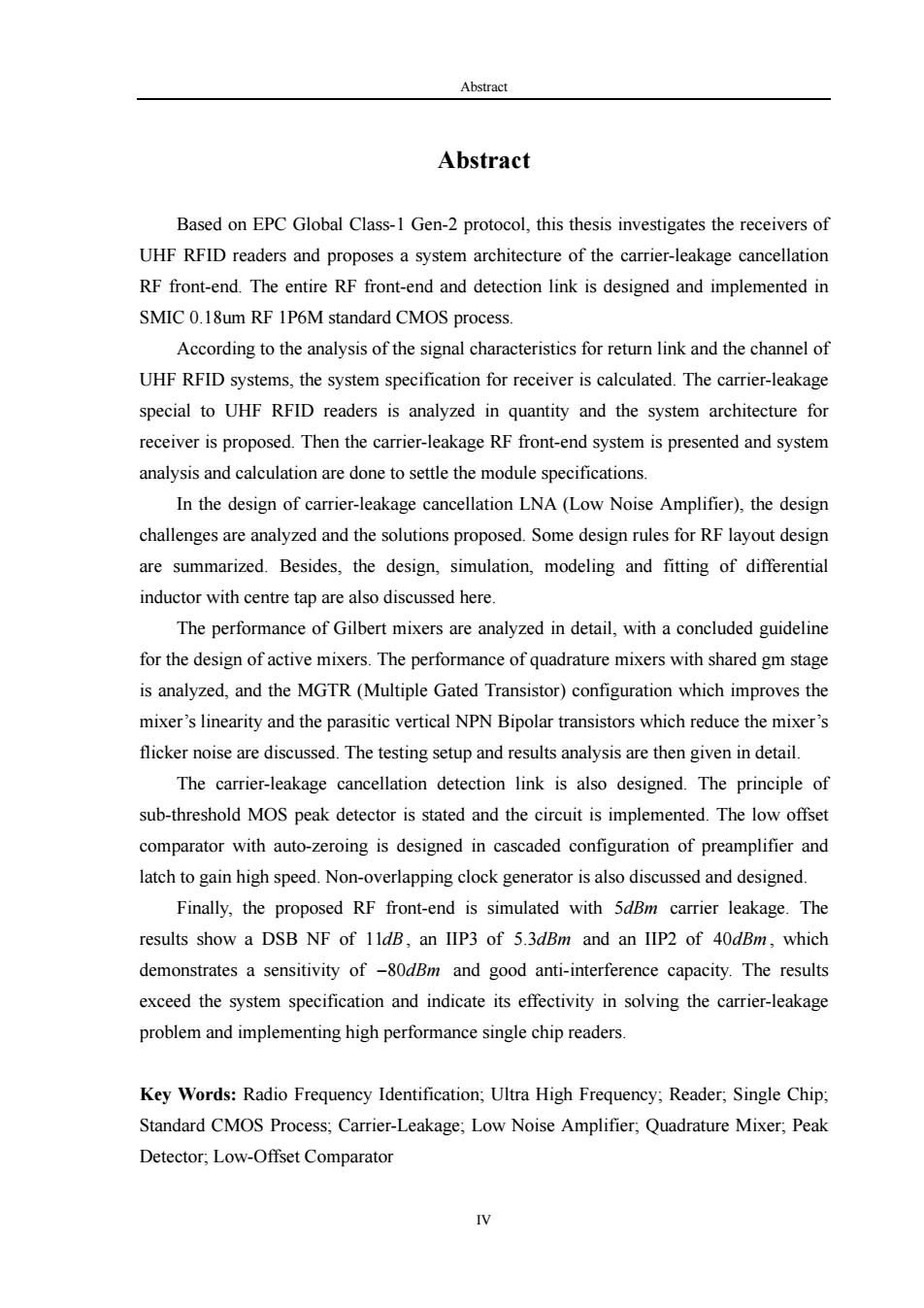
学校代码:10246 学号:052021048 復大婴 硕士学位论文 超高频射频识别读写器接收机 载波消除射频前端的研究与设计 院 系: 信息科学与工程学院 专 业: 微电子学与固体电子学 姓 名: 倪熔华 指导教师: 闵昊 教授 完成日期:2008年5月5日
学校代码: 10246 学 号: 052021048 硕 士 学 位 论 文 超高频射频识别读写器接收机 载波消除射频前端的研究与设计 院 系: 信息科学与工程学院 专 业: 微电子学与固体电子学 姓 名: 倪熔华 指 导 教 师: 闵 昊 教授 完 成 日 期: 2008 年 5 月 5 日

目录 目录 摘要… Abstract.… .....V 第一章引言 1.1 研究背景… 1.2 UHF RFID读写器的研究进展 2 1.2.1 UHF RFID系统的协议及频率规范 2 1.2.2 UHF RFID读写器的研究现状及技术难点.3 1.3论文的主要工作及组织结构. 6 第二章UHF RFID读写器接收机载波消除射频前端系统架构, 0…8 2.1 UHF RFID系统分析及读写器接收机系统指标…8 2.1.1 UHF RFID系统协议分析 2.1.2 UHF RFID系统信道分析. 10 2.1.3 UHF RFID读写器接收机系统指标 11 2.2 UHF RFID读写器接收机系统架构.13 2.2.1 UHF RFID读写器接收机前端载波泄漏分析 13 2.2.2 UHF RFID读写器接收机系统架构 15 2.3 UHF RFID读写器接收机载波消除射频前端系统架构 16 2.3.1 UHF RFID读写器接收机载波消除射频前端系统架构. 16 2.3.2 UHF RFID读写器接收机载波消除射频前端系统指标 .17 第三章载波消除低噪声放大器的设计与实现 .21 3.1LNA的原理及应用 .21 3.2载波消除LNA的设计与实现. 22 3.2.1载波消除LNA的设计难点 22 3.2.2载波消除LNA的电路结构 23 3.2.3带中心抽头的差分叠层电感的设计 24 3.2.4载波消除LNA性能分析 28 3.3载波消除LNA的测试考虑和版图后仿 31 3.3.1测试考虑.… .31 3.3.2版图设计.… 32 3.3.3版图后仿. 33
目录 I 目录 摘要......................................................................................................................................... III Abstract .................................................................................................................................. IV 第一章 引言........................................................................................................................... 1 1.1 研究背景 ................................................................................................................. 1 1.2 UHF RFID 读写器的研究进展 ............................................................................. 2 1.2.1 UHF RFID 系统的协议及频率规范 ......................................................... 2 1.2.2 UHF RFID 读写器的研究现状及技术难点 ............................................. 3 1.3 论文的主要工作及组织结构 ................................................................................. 6 第二章 UHF RFID 读写器接收机载波消除射频前端系统架构 ..................................... 8 2.1 UHF RFID 系统分析及读写器接收机系统指标 ................................................. 8 2.1.1 UHF RFID 系统协议分析 ......................................................................... 8 2.1.2 UHF RFID 系统信道分析 ....................................................................... 10 2.1.3 UHF RFID 读写器接收机系统指标 ........................................................ 11 2.2 UHF RFID 读写器接收机系统架构 ................................................................... 13 2.2.1 UHF RFID 读写器接收机前端载波泄漏分析 ....................................... 13 2.2.2 UHF RFID 读写器接收机系统架构 ....................................................... 15 2.3 UHF RFID 读写器接收机载波消除射频前端系统架构 ................................... 16 2.3.1 UHF RFID 读写器接收机载波消除射频前端系统架构 ....................... 16 2.3.2 UHF RFID 读写器接收机载波消除射频前端系统指标 ....................... 17 第三章 载波消除低噪声放大器的设计与实现 ................................................................ 21 3.1 LNA 的原理及应用 ............................................................................................. 21 3.2 载波消除 LNA 的设计与实现 ............................................................................ 22 3.2.1 载波消除 LNA 的设计难点 .................................................................... 22 3.2.2 载波消除 LNA 的电路结构 .................................................................... 23 3.2.3 带中心抽头的差分叠层电感的设计 ....................................................... 24 3.2.4 载波消除 LNA 性能分析 ........................................................................ 28 3.3 载波消除 LNA 的测试考虑和版图后仿 ............................................................ 31 3.3.1 测试考虑 ................................................................................................... 31 3.3.2 版图设计 ................................................................................................... 32 3.3.3 版图后仿 ................................................................................................... 33

目录 第四章正交下变频混频器的设计与实现 .35 4.1 Gilbert混频器的性能分析.. .35 4.1.1 Gilbert混频器结构 35 4.1.2 Gilbert混频器性能分析 .36 4.1.3 Gilbert混频器设计准则 43 4.2 正交下变频混频器的设计… 43 4.2.1正交下变频共用跨导级的性能分析. 43 4.2.2MGTR技术提高混频器线性度的原理分析与电路实现 50 4.2.3寄生垂直NPN BJT在混频器中的应用. .52 4.2.4正交下变频混频器的设计及优化, 54 4.2.5版图设计 .57 4.3正交下变频混频器的测试与分析. 58 4.3.1PCB设计 58 4.3.2芯片测试与分析 61 第五章载波消除检测电路的设计与射频前端的系统仿真 …65 5.1亚阈值MOS管峰值检测器 65 5.1.1工作原理 65 5.1.2电路设计 67 5.1.3版图后仿 68 5.2低失调比较器 70 5.2.1性能指标及电路结构 70 5.2.2比较器电路设计 71 5.2.3非交叠时钟发生器设计 75 5.2.4版图设计及后仿 77 5.3射频前端的系统仿真 80 第六章总结与展望 83 6.1总结 83 6.2展望 84 附录A 标签天线散射能量与入射能量的比值 85 参考文献 …86 致谢 .89 n
目录 II 第四章 正交下变频混频器的设计与实现 ........................................................................ 35 4.1 Gilbert 混频器的性能分析 .................................................................................. 35 4.1.1 Gilbert 混频器结构 .................................................................................. 35 4.1.2 Gilbert 混频器性能分析 .......................................................................... 36 4.1.3 Gilbert 混频器设计准则 .......................................................................... 43 4.2 正交下变频混频器的设计 ................................................................................... 43 4.2.1 正交下变频共用跨导级的性能分析 ....................................................... 43 4.2.2 MGTR 技术提高混频器线性度的原理分析与电路实现 ...................... 50 4.2.3 寄生垂直 NPN BJT 在混频器中的应用 ................................................. 52 4.2.4 正交下变频混频器的设计及优化 ........................................................... 54 4.2.5 版图设计 ................................................................................................... 57 4.3 正交下变频混频器的测试与分析 ....................................................................... 58 4.3.1 PCB 设计 .................................................................................................. 58 4.3.2 芯片测试与分析 ....................................................................................... 61 第五章 载波消除检测电路的设计与射频前端的系统仿真 ............................................ 65 5.1 亚阈值 MOS 管峰值检测器 ................................................................................ 65 5.1.1 工作原理 ................................................................................................... 65 5.1.2 电路设计 ................................................................................................... 67 5.1.3 版图后仿 ................................................................................................... 68 5.2 低失调比较器 ....................................................................................................... 70 5.2.1 性能指标及电路结构 ............................................................................... 70 5.2.2 比较器电路设计 ....................................................................................... 71 5.2.3 非交叠时钟发生器设计 ........................................................................... 75 5.2.4 版图设计及后仿 ....................................................................................... 77 5.3 射频前端的系统仿真 ........................................................................................... 80 第六章 总结与展望 ............................................................................................................ 83 6.1 总结 ....................................................................................................................... 83 6.2 展望 ....................................................................................................................... 84 附录 A 标签天线散射能量与入射能量的比值 ............................................................... 85 参考文献 ................................................................................................................................ 86 致谢......................................................................................................................................... 89

摘要 摘要 本文基于EPC Global Class-1Gen-2协议对UHF RFID读写器接收机进行了研究, 提出了载波消除射频前端的系统架构,并在SMC0.18umRF1P6M标准CMOS工艺 下实现了完整的射频和载波消除检测链路。 论文首先分析了UHF RFID系统协议接收链路的数据特征和系统信道,计算出了 读写器接收机的性能指标:然后对读写器接收机前端特有的载波泄漏进行了定量分 析,给出了接收机的系统架构:接着提出了载波消除射频前端的系统架构,并进行了 系统分析和计算,为各模块制定了设计目标。 其次,设计了带载波消除功能的低噪声放大器。分析了载波消除LNA的设计难 点并给出了解决方案,接着为射频电路的版图设计提供了一些设计规则。同时讨论了 带中心抽头的差分电感的设计、仿真、建模及拟合。 再次,对Gilbert混频器进行了详细的性能分析,为基于Gilbert单元的有源混频 器的设计提供了准则。分析了正交下变频混频器共用跨导级结构较传统结构的性能优 势,并讨论了多栅晶体管(MGTR)技术提高混频器的线性度和寄生垂直NPN Bipolar 管降低混频器闪烁噪声的原理及电路实现。最后给出了详细的混频器的测试和结果分 析。 论文还设计了载波消除检测电路的各模块。先介绍了亚阈值MOS管峰值检测器 的工作原理,并进行了电路实现。其次利用自较零技术、预放大器和锁存器级联结构 实现了低失调比较器,并对非交叠时钟发生器进行了讨论与设计。 最后,论文对载波消除射频前端链路存在5dBm载波泄漏的情况下进行了系统仿 真。仿真结果表明,射频前端具有1ldB的双边带噪声系数、5.3dBm的IP3和40dBm的 IP2,可以达到-80dBm的灵敏度和较好的抗邻道干扰能力,达到和超过了系统指标, 能有效地解决载波泄漏问题,实现高性能的单芯片读写器。 关键词:射频识别超高频读写器单芯片标准CMOS工艺载波泄漏 低噪声放大器正交混频器峰值检测器低失调比较器 中图分类号:TN492 Ⅲ
摘要 III 摘要 本文基于 EPC Global Class-1 Gen-2 协议对 UHF RFID 读写器接收机进行了研究, 提出了载波消除射频前端的系统架构,并在 SMIC 0.18um RF 1P6M 标准 CMOS 工艺 下实现了完整的射频和载波消除检测链路。 论文首先分析了 UHF RFID 系统协议接收链路的数据特征和系统信道,计算出了 读写器接收机的性能指标;然后对读写器接收机前端特有的载波泄漏进行了定量分 析,给出了接收机的系统架构;接着提出了载波消除射频前端的系统架构,并进行了 系统分析和计算,为各模块制定了设计目标。 其次,设计了带载波消除功能的低噪声放大器。分析了载波消除 LNA 的设计难 点并给出了解决方案,接着为射频电路的版图设计提供了一些设计规则。同时讨论了 带中心抽头的差分电感的设计、仿真、建模及拟合。 再次,对 Gilbert 混频器进行了详细的性能分析,为基于 Gilbert 单元的有源混频 器的设计提供了准则。分析了正交下变频混频器共用跨导级结构较传统结构的性能优 势,并讨论了多栅晶体管(MGTR)技术提高混频器的线性度和寄生垂直 NPN Bipolar 管降低混频器闪烁噪声的原理及电路实现。最后给出了详细的混频器的测试和结果分 析。 论文还设计了载波消除检测电路的各模块。先介绍了亚阈值 MOS 管峰值检测器 的工作原理,并进行了电路实现。其次利用自较零技术、预放大器和锁存器级联结构 实现了低失调比较器,并对非交叠时钟发生器进行了讨论与设计。 最后,论文对载波消除射频前端链路存在5dBm载波泄漏的情况下进行了系统仿 真。仿真结果表明,射频前端具有11dB的双边带噪声系数、5.3dBm的 IIP3 和40dBm 的 IIP2,可以达到−80dBm 的灵敏度和较好的抗邻道干扰能力,达到和超过了系统指标, 能有效地解决载波泄漏问题,实现高性能的单芯片读写器。 关键词:射频识别 超高频 读写器 单芯片 标准 CMOS 工艺 载波泄漏 低噪声放大器 正交混频器 峰值检测器 低失调比较器 中图分类号:TN492

Abstract Abstract Based on EPC Global Class-1 Gen-2 protocol,this thesis investigates the receivers of UHF RFID readers and proposes a system architecture of the carrier-leakage cancellation RF front-end.The entire RF front-end and detection link is designed and implemented in SMIC 0.18um RF 1P6M standard CMOS process. According to the analysis of the signal characteristics for return link and the channel of UHF RFID systems,the system specification for receiver is calculated.The carrier-leakage special to UHF RFID readers is analyzed in quantity and the system architecture for receiver is proposed.Then the carrier-leakage RF front-end system is presented and system analysis and calculation are done to settle the module specifications. In the design of carrier-leakage cancellation LNA (Low Noise Amplifier),the design challenges are analyzed and the solutions proposed.Some design rules for RF layout design are summarized.Besides,the design,simulation,modeling and fitting of differential inductor with centre tap are also discussed here. The performance of Gilbert mixers are analyzed in detail,with a concluded guideline for the design of active mixers.The performance of quadrature mixers with shared gm stage is analyzed,and the MGTR(Multiple Gated Transistor)configuration which improves the mixer's linearity and the parasitic vertical NPN Bipolar transistors which reduce the mixer's flicker noise are discussed.The testing setup and results analysis are then given in detail. The carrier-leakage cancellation detection link is also designed.The principle of sub-threshold MOS peak detector is stated and the circuit is implemented.The low offset comparator with auto-zeroing is designed in cascaded configuration of preamplifier and latch to gain high speed.Non-overlapping clock generator is also discussed and designed. Finally,the proposed RF front-end is simulated with 5dBm carrier leakage.The results show a DSB NF of 11dB,an IIP3 of 5.3dBm and an IIP2 of 40dBm,which demonstrates a sensitivity of -80dBm and good anti-interference capacity.The results exceed the system specification and indicate its effectivity in solving the carrier-leakage problem and implementing high performance single chip readers. Key Words:Radio Frequency Identification;Ultra High Frequency;Reader;Single Chip; Standard CMOS Process;Carrier-Leakage;Low Noise Amplifier;Quadrature Mixer;Peak Detector;Low-Offset Comparator IV
Abstract IV Abstract Based on EPC Global Class-1 Gen-2 protocol, this thesis investigates the receivers of UHF RFID readers and proposes a system architecture of the carrier-leakage cancellation RF front-end. The entire RF front-end and detection link is designed and implemented in SMIC 0.18um RF 1P6M standard CMOS process. According to the analysis of the signal characteristics for return link and the channel of UHF RFID systems, the system specification for receiver is calculated. The carrier-leakage special to UHF RFID readers is analyzed in quantity and the system architecture for receiver is proposed. Then the carrier-leakage RF front-end system is presented and system analysis and calculation are done to settle the module specifications. In the design of carrier-leakage cancellation LNA (Low Noise Amplifier), the design challenges are analyzed and the solutions proposed. Some design rules for RF layout design are summarized. Besides, the design, simulation, modeling and fitting of differential inductor with centre tap are also discussed here. The performance of Gilbert mixers are analyzed in detail, with a concluded guideline for the design of active mixers. The performance of quadrature mixers with shared gm stage is analyzed, and the MGTR (Multiple Gated Transistor) configuration which improves the mixer’s linearity and the parasitic vertical NPN Bipolar transistors which reduce the mixer’s flicker noise are discussed. The testing setup and results analysis are then given in detail. The carrier-leakage cancellation detection link is also designed. The principle of sub-threshold MOS peak detector is stated and the circuit is implemented. The low offset comparator with auto-zeroing is designed in cascaded configuration of preamplifier and latch to gain high speed. Non-overlapping clock generator is also discussed and designed. Finally, the proposed RF front-end is simulated with 5dBm carrier leakage. The results show a DSB NF of 11dB , an IIP3 of 5.3dBm and an IIP2 of 40dBm , which demonstrates a sensitivity of −80dBm and good anti-interference capacity. The results exceed the system specification and indicate its effectivity in solving the carrier-leakage problem and implementing high performance single chip readers. Key Words: Radio Frequency Identification; Ultra High Frequency; Reader; Single Chip; Standard CMOS Process; Carrier-Leakage; Low Noise Amplifier; Quadrature Mixer; Peak Detector; Low-Offset Comparator